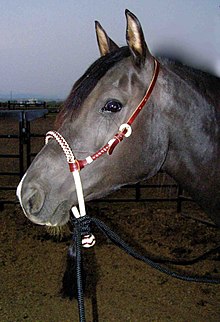

A hackamore (or jáquima) is a type of animal headgear which does not have a bit. Instead, it has a special type of noseband that works on pressure points on the face, nose, and chin. Hackamores are most often seen in western riding and other styles of riding derived from Spanish traditions, and are occasionally seen in some English riding disciplines such as show jumping and the stadium phase of eventing. Various hackamore designs are also popular for endurance riding. While usually used to start young horses, they are often seen on mature horses with dental issues that make bit use painful, and on horses with mouth or tongue injuries that would be aggravated by a bit. Some riders also like to use them in the winter to avoid putting a frozen metal bit into a horse's mouth.
There are many styles, but the classic hackamore design features a bosal (bozal) noseband, and sometimes itself called a "bosal" or a "bosal hackamore". It has a long rope rein called a mecate and may also add a type of stabilizing throatlatch called a fiador, which is held to the hackamore by a browband. Other designs with heavy nosebands are also called hackamores, though some bitless designs with lighter weight nosebands that work off tension rather than weight are also called bitless bridles. A noseband with shanks and a curb chain to add leverage is called a mechanical hackamore, but is not considered a true hackamore. A simple leather noseband, or cavesson, is not a hackamore; a noseband is generally used in conjunction with a bit and bridle.
Like a bit, a hackamore can be gentle or harsh, depending on the hands of the rider. The horse's face is very soft and sensitive with many nerve endings. Misuse of a hackamore can not only cause pain and swelling on the nose and jaw, but improper fitting combined with rough use can cause damage to the cartilage on the horse's nose.